NCERT Class 12 Physics Chapter 5 Notes, Magnetism and Matter Class 12 Chapter 5 Notes
Have you ever trekked while using a compass or observed how certain metals like iron are significantly influenced by magnets in your day-to-day lives? Such experiences are physical consequences of magnetism and matter, which is the theme of NCERT Class 12 Physics Chapter 5 Notes Magnetism and Matter.
This Story also Contains
- NCERT Class 12 Physics Chapter 5 Notes: Download PDF
- NCERT Notes for Class 12 Physics Chapter 5
- Magnetism and Matter: Previous Year Question and Answer
- Importance of NCERT Class 12 Physics Chapter 5 Notes
- NCERT Class 12 Notes Chapterwise
- NCERT Books and Syllabus
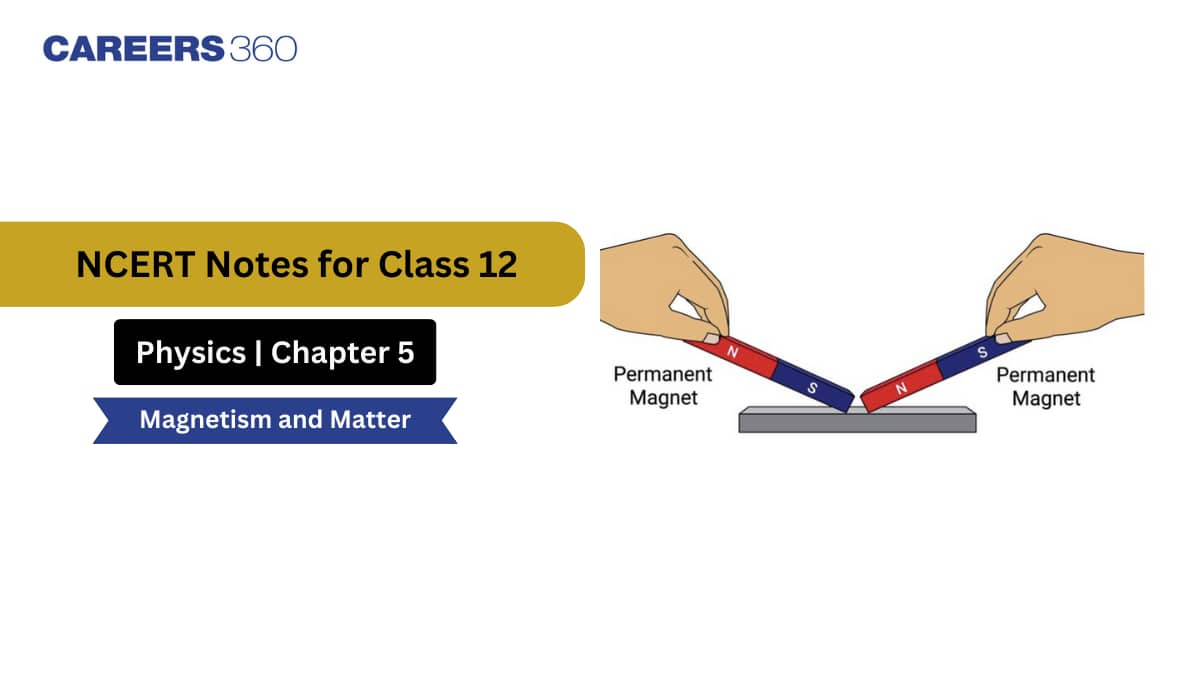
In this chapter, students learn about magnetic fields and magnetic dipoles, solenoids, bar magnets, and the magnetic properties of materials in detail. The beauty of the NCERT Class 12 Physics Chapter 5 Notes Magnetism and Matter is that they explain these concepts with beautiful diagrams, stepwise derivations, and definitions that will provide clarity in your learning of the subject matter. The chapter has a lot of important concepts, such as magnetic field lines, magnetic susceptibility, and the reaction of various materials when exposed to magnetic treatment, and these are presented plainly in the study notes. In the hands of experts, and using the most current syllabus that is implemented by the CBSE for Class 12 Physics, Class 12 NCERT notes are excellent study tools for board exams and those preparing for competitive exams such as JEE and NEET. By using revision notes that are succinct, students may gain problem-solving capacity, retain relevant formulas, and apply their localisation to everyday scenarios in life.
Also, students can refer,
NCERT Class 12 Physics Chapter 5 Notes: Download PDF
Chapter 5 – Magnetism and Matter explores the fascinating properties of magnets and how materials behave under magnetic influence. These NCERT Class 12 Physics Chapter 5 Notes are concise, easy to revise, and cover all key formulas, diagrams, and concepts, making them perfect for both CBSE exams and competitive tests like JEE and NEET.
NCERT Notes for Class 12 Physics Chapter 5
Class 12 Physics Chapter 5 – Magnetism and Matter is concerned with finding the origin of magnetism, studying magnetic dipoles, and studying the properties of different materials. These Magnetism and Matter Class 12 Notes provide simplified explanations, summarised forms, important formulas and diagrams, fully assisting students for quick revision and effective preparation for board exams and competitive tests.
Magnetism and Matter:
-
Magnetism can be defined as the phenomenon by which certain substances attract pieces of steel, iron, nickel, etc.
-
We find the use of magnets in many devices, like an electric bell, telephone, radio, loudspeaker, motors, fans, screwdrivers, lifting heavy iron loads, super-fast trains, especially in foreign countries, refrigerator,s etc.
-
Magnetite is considered to be the world’s first magnet. It is also known as a natural magnet. Magnets occur naturally, but we can impart magnetic property on a substance as well. Doing so will create an artificial magnet.
History of magnets
-
During 600 BC in Greece, it was observed by the shepherds that their wooden shoes, which had iron nails used to strike at some places on the ground.
-
This was due to an island in Greece called Magnesia, which had magnetic ore deposits. The word magnet was taken from there.
-
The technological use of magnets began around 400 BC by the Chinese. When a thin piece of magnet was suspended freely it always used to point towards the North-South direction. This phenomenon was used by the Chinese emperor Huang-ti to win a war.
Magnet Properties
-
The Earth behaves like a magnet.
-
When a bar magnet is freely suspended, it points towards the geographical North-South direction.
-
Like poles repel one another, and in contrast to unlike poles attract one another.
-
There is no existence of Magnetic monopoles, which suggests we tend not to have a magnet with the North pole alone or the South pole alone.
-
If a bar magnet is broken into two halves, we will get two bar magnets that are similar with weaker properties.
-
Using iron and its alloys, magnets can be made.
Magnetic Field Lines
-
When we sprinkle iron filings on a sheet of glass that is placed over a short bar magnet, a pattern is observed. The pattern below shows that the magnet has two poles.
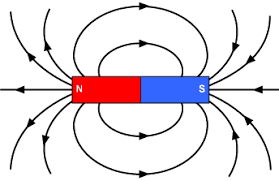
-
The magnetic field lines inside and around the magnet are imaginary lines.
Properties of the Magnetic Field Lines
The properties of the magnetic field lines are as follows-
-
The field lines are continuous outside the magnet. They are considered to originate from the North Pole and terminate at the South Pole.
-
They are kind of closed loops traversing within the magnet; however, the lines appear to originate from the South Pole and terminate at the North Pole to create closed loops.
-
A wider range of shut lines indicates a stronger flux of the magnet.
-
The field lines never intersect each other.
-
The tangent drawn at the sector line provides the direction of the flux at that time.
Bar Magnet as Equivalent Solenoid
The magnetic field at a far axial point of a solenoid:
Let us consider
-
2l to be the length of the solenoid
-
a to be the radius of the solenoid
-
n to be the number of turns/unit length
-
r to be the distance of the point P from the centre of the solenoid O
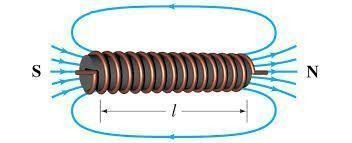
The magnetic moment of the solenoid is given by (total number of turns X current X cross-sectional area) which is
A bar magnet is considered to be a large number of circulating currents analogous to a solenoid.
|
S.No. |
Bar magnet |
Solenoid |
|
1 |
It is a natural magnet. |
It is an artificial magnet. |
|
2 |
If we cut a bar magnet into two pieces, it results in smaller bar magnets. Monopoles are not possible |
If we cut a solenoid, it results in smaller solenoids of weaker fields. |
|
3 |
The magnetic field found at a far axial point is the same. | |
|
4 |
Magnetic moments are the same in both. |
Dipole Moment of Circular Current Loop
The current-carrying circular loop of N turns is similar to a magnetic dipole. In a current-carrying circular loop, if we see from one side, say the right side, the current appears to move in a clockwise direction. This is like the South polarity. If we see it from the opposite face, say the left face, this seems to manoeuvre within the anticlockwise direction that is like the North polarity.
The dipole moment of a current-carrying loop is given by
M = IA
where
I is the current
A is the area of cross-section of the coil
If there are N such turns of the coil, then the Magnetic dipole moment will be M = NIA
The expression for the moment in the case of the current-carrying loop with N turns is quite similar to the rectangular loop placed in a uniform magnetic field with area vector A. In both cases, m = NIA
.png)
Dipole in a Uniform Magnetic Field
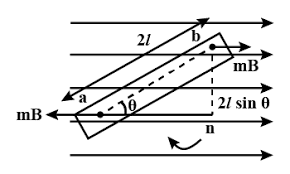
Let a bar magnet NS having pole strength ‘m’ and of length 2lbe placed in a uniform magnetic field of strength B making an angle with the direction of the magnetic field.
Force on N-pole of the magnet =mB(along the direction of magnetic field B)
Force on S-pole of the magnet =mB(opposite to the direction of magnetic field B)
Thus, the bar magnet is acted upon by two equal, parallel and opposite forces. The two forces constitute a torque, and it tends to rotate the magnet in the clockwise direction. The magnitude of the torque is given by
Torque= either force x perpendicular distance between the two forces
Since mx2l=M, the magnetic dipole moment of the bar magnet, we have
If
Hence, the magnetic dipole moment of a magnetic dipole is numerically equal to the torque acting on the dipole when placed perpendicular to the direction of a uniform magnetic field of unit strength.
Unit of magnetic dipole moment
The unit of magnetic dipole moment is
Potential Energy of a Bar Magnet Placed in a Magnetic Field
Let a bar magnet of dipole moment M be placed in a uniform magnetic field of strength B, such that the magnet makes an angle with the direction of the field. Then, the magnitude of the torque acting on the dipole is given by
This torque tends to align the magnet along the direction of the field. If the magnet is rotated against the action of this torque, work has to be done. Suppose that the magnet is rotated through an infinitesimally small angle dθ,
If the magnet is rotated from the initial position θ= θ1 to the final position θ= θ2, then the total work done is given by
The work done in rotating the magnet is stored inside the magnet as its potential energy (U). Thus, the potential energy of the magnet inside the magnetic field.
Suppose that the magnet is initially perpendicular to the direction of the magnetic field, i.e. θ1=90o. Then, the potential energy of the magnet in any position making angle θ with the direction of the field can be obtained by setting θ1=90o and θ2=θ in the equation
Gauss’ Law in Magnetism
Gauss's Law of magnetism states that the flux of the magnetic field through any closed surface is zero (as shown in the figure below). It is because, inside the closed surface, the simplest magnetic element is a magnetic dipole with both poles (since a magnet with a monopole does not exist). So, several magnetic field lines entering the surface equals the number of magnetic field lines leaving the surface. So the net magnetic flux through any closed surface is zero.

Magnetic Flux
Magnetic flux is a measure of the quantity of magnetism, considering the strength and the extent of a magnetic field. It is defined as the product of the magnetic field (B) and the area (A) through which the field lines pass, and it also depends on the angle (θ) between the magnetic field and the normal (perpendicular) to the surface. It is defined as the magnetic lines of force passing normally through a surface called magnetic flux.
The Gauss Law for a closed surface is,
Magnetisation and Magnetic Intensity
Magnetisation and Magentic Intensity are concepts of magnetism that allows us to explain the behaviour of different materials and their magnetic properties.
Magnetisation
As we know, the nucleus of the atom consists of Neutrons and charged protons; the electrons that are charged revolve around the nucleus. Thus, the circulating electron in an atom will have a magnetic moment.
Material is made of many atoms, and it will have multiple magnetic moments. These magnetic moments add up in vector form and give a net magnetic moment which is non-zero.
which is the net magnetic moment per unit volume. Its unit is A/m2
Magnetic Intensity / Magnetising force H
Let us consider a solenoid of n turns per unit length and carrying a current I.
The inner part of the solenoid is filled with a material that has non-zero magnetisation (M).
Dividing by μ0
This change in the magnetic field with permeability is called Magnetic intensity.
H depends on external factors like current flowing etc.
M depends on the material kept inside the solenoid
Susceptibility
In the expression,
M depends on external factors as well.
Hence,
X(khi) which is a dimensionless quantity, is called Susceptibility. It tells the response of magnetic material to an external field. It is a dimensionless quantity.
Permeability
μ is called the magnetic permeability of the substance.
µr is called the relative magnetic permeability of the substance.
Its unit is Tm/A.
Magnetic Properties of Materials
Based on the magnetic behaviour of different magnetic materials, Faraday divided the magnetic materials into three categories:-
Diamagnetic
The substances placed in a magnetic field are feebly magnetised in the opposite direction to the magnetising field are called diamagnetic substances.
When a diamagnetic substance is placed inside an external magnetic field, the magnetic field inside the diamagnetic substance is slightly less than the external magnetic field. When diamagnetic material is kept inside a non-uniform magnetic field, it prefers to move from the stronger magnetic field to the weaker magnetic field. Despite the application of a strong magnetic field, the diamagnetic effects are too weak to be detected. Some examples of diamagnetic substances include zinc, gold, copper, bismuth, silver, lead, glass, marble, helium, etc
A diamagnetic substance has a small negative value for the magnetic susceptibility
The order is of
The status of a magnetic force substance doesn't change with temperature for sensible functions. However, at low temperature,s bismuth is an exception.
Paramagnetic
The substances, in the direction of the magnetising field, are weakly magnetised and known as paramagnetic substances.
If the paramagnetic substance is kept inside an external magnetic field, it is observed that the magnetic field inside the substance is slightly greater than the external magnetic field. A paramagnetic substance, when placed in a non-uniform magnetic field, tends to move from the weaker part of the magnetic field to the stronger part. When a strong magnetic field is there, then the paramagnetic effects are perceptible. Examples of paramagnetic substances are aluminium, sodium, antimony, platinum, copper chloride, liquid oxygen etc.
Paramagnetic substances have a small positive value for the magnetic susceptibility
It is of the order of
The susceptibility of paramagnetic substances is generally inversely proportional to their absolute temperature.
Ferromagnetic
Those substances, once placed in an exceedingly field, are unit powerfully magnetic within the direction of the magnetizing field, are area units known as magnetic force substances.
When a magnetic force substance is placed within an associate degree external field, the field within the ferromagnetic material is found to be greatly increased from the external field. As a result, once a magnetic force substance is placed in an exceedingly non-uniform field, it quickly moves from the weaker half to the stronger part of the field. In other words, the magnetic force affects an area unit perceptible even within the presence of a weak field. A number of the few samples of magnetic force substances are unit iron, nickel, cobalt, alnico etc.
Ferromagnetic substances have a large positive value for magnetic susceptibility Xm
It is of the order of several thousand. With the rise in temperature, the susceptibility of ferromagnetic substances decreases.
Hysteresis
The word hysteresis means lagging behind. The property of insulant intensity of magnetisation (M) behind magnetic flux density (H), once a specimen of magnetic material is subjected to a cycle of magnetisation, is termed hthe ysteresis phenomenon.
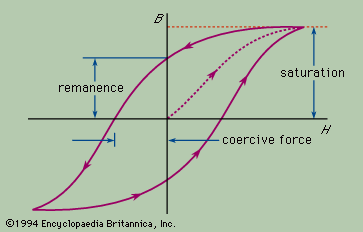
The curve shown would vary for different materials like steel, soft iron, etc.
Magnetism and Matter: Previous Year Question and Answer
Q. 1 The magnetic dipole moment of a current-carrying coil does not depend upon-
(1) number of turns of the coil.
(2) cross-sectional area of the coil.
(3) current flowing in the coil.
(4) material of the coil.
Answer:
Magnetic dipole moment M=NIA
N is the number of turns
I am the current
A is the cross-sectional area
The magnetic dipole moment of a current-carrying coil does not depend upon the material of the turns of the coil.
Hence, the answer is option (4).
Q. 2 Identify the following magnetic materials:
(i) A material having susceptibility
(ii) A material having susceptibility
Answer:
(i)
Negative sign indicates that the material repels magnetic fields. Since the value is very small, the material is diamagnetic.
(ii)
The material is weakly attracted to magnetic fields. Hence, it is paramagnetic.
Q. 3 Two identical bars, one of paramagnetic material and the other of diamagnetic material, are kept in a uniform external magnetic field parallel to it. Draw diagrammatically the modifications in the magnetic field pattern in each case.
Answer:
According to the properties of paramagnetic and diamagnetic materials, we can draw the following.
Diamagnetic

Paramagnetic

Importance of NCERT Class 12 Physics Chapter 5 Notes
Building Blocks of Physics Concepts
- This chapter includes the basics of magnetism, Earth's magnetism, and material properties, which are essential foundations for future studies in physics and engineering.
Boosts Exam Preparation
- Having concise and organised notes with all the important definitions, formulas, and diagrams helps you revise as well as gives you a greater chance of being accurate in the CBSE Class 12 boards.
Beneficial in Competitive Exams
- The concepts highlighted in this chapter, such as magnetic dipoles, susceptibility, and Earth's magnetic field, are common in the JEE and NEET exams.
Bridges the gap between Science and Real Life
- It helps students understand real-world phenomena such as compass travel, the functioning of magnets in electrical devices, and Earth's magnetic layer allows for some protection against solar radiation.
Time Saver for Quick Revision
- Summary notes are concise and organised, allowing for a last-minute condensed approach to studying without leaving any fundamental concepts out.
NCERT Class 12 Notes Chapterwise
NCERT Class 12 Notes chapterwise are a complete study aid for board exam preparation and competitive exams like JEE and NEET. These notes provide concise summaries, important formulas, solved examples, and diagrams for every chapter, making complex topics easier to revise quickly. With chapterwise links, students can access any topic instantly and prepare smartly.
|
NCERT Class 12 Physics Chapter 5 Notes |
Subject Wise NCERT Exemplar Solutions
Subject Wise NCERT Solutions
NCERT Books and Syllabus
Frequently Asked Questions (FAQs)
Earth behaves like a giant bar magnet with a magnetic field that protects us from solar radiation. It is crucial for navigation (compasses) and understanding the planet’s magnetic behavior.
Hysteresis refers to the lag between magnetization and the applied magnetic field in a material. It’s depicted using a hysteresis loop and is important in designing transformers and magnetic storage devices.
Concepts from this chapter are used in compasses, MRI machines, magnetic levitation trains, transformers, and memory devices.
Yes, it typically carries 4–5 marks in the CBSE Class 12 Physics board exam and often includes both theory-based and conceptual questions.
While it's less numerically intensive than some other chapters, it is conceptually important for exams like JEE Main, JEE Advanced, and NEET, especially in questions involving magnetic materials and Earth’s field.
Popular Questions
Courses After 12th
Applications for Admissions are open.
As per latest syllabus. Physics formulas, equations, & laws of class 11 & 12th chapters
JEE Main Important Chemistry formulas
Get nowAs per latest syllabus. Chemistry formulas, equations, & laws of class 11 & 12th chapters
JEE Main high scoring chapters and topics
Get nowAs per latest 2024 syllabus. Study 40% syllabus and score upto 100% marks in JEE
JEE Main Important Mathematics Formulas
Get nowAs per latest syllabus. Maths formulas, equations, & theorems of class 11 & 12th chapters
